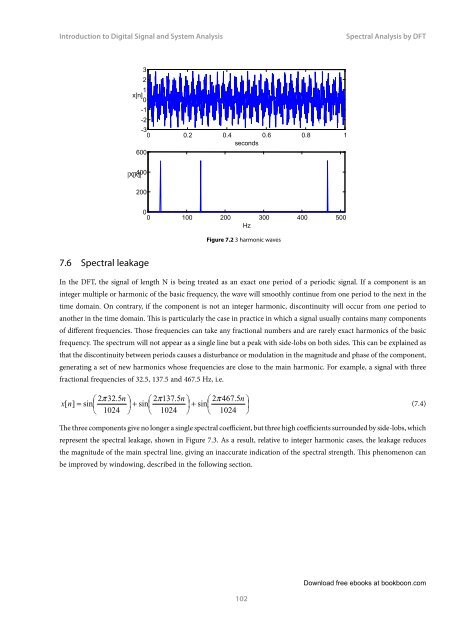Introduction to Digital Signal and System Analysis - Tutorsindia
Introduction to Digital Signal and System Analysis - Tutorsindia
Introduction to Digital Signal and System Analysis - Tutorsindia
Create successful ePaper yourself
Turn your PDF publications into a flip-book with our unique Google optimized e-Paper software.
<strong>Introduction</strong> <strong>to</strong> <strong>Digital</strong> <strong>Signal</strong> <strong>and</strong> <strong>System</strong> <strong>Analysis</strong><br />
Spectral <strong>Analysis</strong> by DFT<br />
3<br />
2<br />
1<br />
x[n]<br />
0<br />
-1<br />
-2<br />
-3<br />
0 0.2 0.4 0.6 0.8 1<br />
seconds<br />
600<br />
|X[k]| 400<br />
200<br />
0<br />
0 100 200 300 400 500<br />
Hz<br />
Figure 7.2 3 harmonic waves<br />
7.6 Spectral leakage<br />
In the DFT, the signal of length N is being treated as an exact one period of a periodic signal. If a component is an<br />
integer multiple or harmonic of the basic frequency, the wave will smoothly continue from one period <strong>to</strong> the next in the<br />
time domain. On contrary, if the component is not an integer harmonic, discontinuity will occur from one period <strong>to</strong><br />
another in the time domain. This is particularly the case in practice in which a signal usually contains many components<br />
of different frequencies. Those frequencies can take any fractional numbers <strong>and</strong> are rarely exact harmonics of the basic<br />
frequency. The spectrum will not appear as a single line but a peak with side-lobs on both sides. This can be explained as<br />
that the discontinuity between periods causes a disturbance or modulation in the magnitude <strong>and</strong> phase of the component,<br />
generating a set of new harmonics whose frequencies are close <strong>to</strong> the main harmonic. For example, a signal with three<br />
fractional frequencies of 32.5, 137.5 <strong>and</strong> 467.5 Hz, i.e.<br />
2π<br />
32.5n<br />
2π<br />
137.5n<br />
2π<br />
467.5n<br />
<br />
x[<br />
n]<br />
= sin<br />
+ sin<br />
+ sin<br />
<br />
1024 1024 1024 <br />
(7.4)<br />
The three components give no longer a single spectral coefficient, but three high coefficients surrounded by side-lobs, which<br />
represent the spectral leakage, shown in Figure 7.3. As a result, relative <strong>to</strong> integer harmonic cases, the leakage reduces<br />
the magnitude of the main spectral line, giving an inaccurate indication of the spectral strength. This phenomenon can<br />
be improved by windowing, described in the following section.<br />
102<br />
Download free ebooks at bookboon.com
















